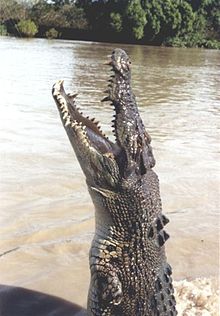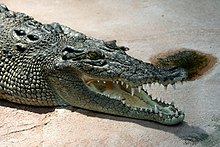Saltwater crocodile
| Saltwater Crocodile | |
|---|---|

| |
| Scientific classification | |
| Kingdom: | |
| Phylum: | |
| Class: | |
| Order: | |
| Family: | |
| Subfamily: | |
| Genus: | |
| Species: | C. porosus
|
| Binomial name | |
| Crocodylus porosus | |

| |
| Range of the saltwater crocodile in black | |
The saltwater or estuarine crocodile (Crocodylus porosus) is the largest of all living crocodilians and reptiles. It is found in suitable habitat throughout Southeast Asia, Northern Australia, and the surrounding waters. Saltwater crocodiles are known in the Northern Territory of Australia as "salties". The Alligator Rivers are misnamed after the resemblance of the "saltie" to alligators as compared to freshwater crocodiles, which also inhabit the Northern Territory.
Anatomy and morphology
The saltwater crocodile has a longer muzzle than the mugger crocodile, is twice the length of its breadth at the base .[1]
An adult male saltwater crocodile can grow 12-16ft sometimes found 16-18ft feet (6 meters) long[2], and weigh more than 1000 kilograms (2,200 pounds).[3] Females are much smaller than males, with typical female body lengths in the range of 7 to 10 ft (2.1 to 3 m).[4][5] The largest females measure about 4.2 m (14 feet).[6] The saltwater crocodile has fewer armor plates on its neck than other crocodilians, and its broad body contrasts with that of most other lean crocodiles, leading to early unverified assumptions that the reptile was an alligator.[4]
The largest size saltwater crocodiles can reach is the subject of considerable controversy. The longest crocodile ever measured snout-to-tail was the skin of a deceased crocodile, which was 20.3 ft (6.2 m) long. Since skins tend to shrink slightly after removal from the carcass, this crocodile's living length was estimated at 20.6 feet (6.3 m) and it probably weighed well over 2,600 pounds.[7] Incomplete remains (the skull of a crocodile shot in Orrissa[8]) have been claimed to come from a 25 ft (7.6 m) crocodile, but scholarly examination suggested a length no greater than 23 ft (7 m).[7] There have been numerous claims of crocodiles in the 30-foot range: the individual shot in the Bay of Bengal in 1840, reported at 10 m (33 ft); another killed in 1823 at Jala Jala on Luzon reported at 8.2 m (27 ft); a reported 25 ft crocodile killed in the Hooghly River in the Alipore District of Calcutta. However, examinations of these animals' skulls actually indicated animals ranging from 6 to 6.6 m (20 to 22 ft).[6]
With recent restoration in saltwater crocodile habitat and reduced poaching, it is possible that 23 ft (7 m) or larger crocodiles are alive today.[9] Guinness has accepted a claim of a 23 ft (7 m) male saltwater crocodile living within Bhitarkanika Park in the state of Orissa, India,[8][10] although no verified measurements have been made.
A crocodile shot in Queensland in 1957 was reported to be 28 ft (8.6 m) long, but no verified measurements were made and no remains of this crocodile exist. A "replica" of this crocodile has been made as a tourist attraction.[11][12][13] Many other unconfirmed reports of 26+ ft (8+ m) crocodiles have been made[14][15] but these are highly suspect.[7]
Distribution
Saltwater crocodiles are severely depleted in numbers through much of their range, with sightings in areas such as Thailand, Cambodia and Vietnam becoming extremely rare and the species may in fact even be extinct in one or more of these countries. However, it is also the least likely of crocodilians to become globally extinct due to its wide distribution and almost pre-colonial population sizes in Northern Australia and New Guinea. In India this crocodile is extremely rare in most areas but is very common in the north eastern part of the country (mainly Orissa and the Sunderbans). The population is sporadic in Indonesia and Malaysia with some areas harboring large populations (Borneo, for example) and others with very small, "at risk" populations (e.g., the Philippines). The saltwater crocodile is also present in very limited parts of the South Pacific, with an average population in the Solomon Islands, a very small and soon to be extinct population in Vanuatu (where the population officially stands at only three) and a decent but at-risk population (which may be rebounding) in Palau.[4]
Saltwater crocodiles once ranged as far west as the east coast of Africa at the Seychelles Islands. These crocodiles were once believed to be a population of Nile crocodiles, but they were later proven to be Crocodylus porosus.[4]
Habitat
Saltwater crocodiles generally spend the tropical wet season in freshwater swamps and rivers, moving downstream to estuaries in the dry season, and sometimes traveling far out to sea. Crocodiles compete fiercely with each other for territory, with dominant males in particular occupying the most eligible stretches of freshwater creeks and streams. Junior crocodiles are thus forced into the more marginal river systems and sometimes into the ocean. This explains the large distribution of the animal (ranging from the east coast of India to northern Australia) as well as its being found in odd places on occasion (such as the Sea of Japan). Saltwater crocodiles can swim 15 to 18 miles per hour in short bursts, but when cruising go 2 to 3 mph.

Behaviour

The saltwater crocodile is an opportunistic apex predator capable of taking animals up to the size of an adult male water buffalo, either in the water or on dry land. They have also been known to attack humans. Juveniles are restricted to smaller animals such as insects, amphibians, crustaceans, small reptiles and fish. The larger the animal grows, the greater the variety of animals it includes in the diet, although relatively small prey make up an important part of the diet even in adults. Saltwater crocodiles can eat monkeys, kangaroo, wild boar, dingos, goannas, birds, domestic livestock, pets, water buffalo, gaurs, leopards, sharks,[16][17] and human beings,[18][9] among other large animals as well. Domestic cattle, horse, water buffalo and gaur, all of which may weigh over a ton, are considered the largest prey taken by male crocodiles. The only threats to adult saltwater crocodiles are other crocodiles.[6] Generally very lethargic – a trait which helps it survive months at a time without food – it typically loiters in the water or basks in the sun through much of the day, preferring to hunt at night. Capable of explosive bursts of speed when launching an attack from the water, many species of crocodile are also capable of fast land-movement. Many crocodiles are capable of explosive charges that can carry them nearly as fast as a running human. The 23 species of crocodilian can travel over land using the belly crawl, the walk, the high-walk, and the gallop. However, stories of crocodiles being faster than a race horse for short distances across the ground are little more than urban legend.
As an ambush predator, it usually waits for its prey to get close to the water's edge before striking, using its great strength to drag the animal back into the water. Most prey animals are killed by the great jaw pressure of the crocodile, although some animals may be incidentally drowned. It is an immensely powerful animal, having the strength to drag a fully grown water buffalo into a river, or crush a full-grown bovid's skull between its jaws.
In its most deadly attack, called the "death roll," it grabs onto the animal and rolls powerfully. This is designed to initially throw any struggling large animal off balance making it easier to drag it into the water. The "death roll" is also used for tearing apart large animals once they are dead.
Although saltwater crocodiles are very dangerous animals, attacks on humans are infrequent. Most attacks by adult "salties" are fatal, given the animals' size and strength. In Australia, attacks are rare and usually make headlines when they do occur. There are, on average, no more than one or two fatal attacks reported per year in the country.[19] The low level of attacks is most likely due to the extensive effort by local wildlife officials to post crocodile "warning" signs at nearly every billabong, river, lake and even at some beaches and also due to the relatively well-informed nature of the local citizens. In the Aboriginal community of Arnhem Land, which occupies roughly half of the top end of the Northern Territory, attacks may go unreported and may be more common. In the remaining portion of the crocodile's range, where very few attacks are reported and there's none of the precautions taken in Australia, attacks have been estimated to number up to the thousands annually.[6]
Intelligence

Dr. Adam Britton, a researcher with Big Gecko, has been studying crocodilian intelligence. In so doing, he has compiled a collection of Australian saltwater crocodile calls, and associated them with behaviors. His position is that while crocodilian brains are much smaller than those of mammals (as low as 0.05% of body weight in the saltwater crocodile), they are capable of learning hard tasks with very little conditioning. He also infers that the crocodile calls hint at a deeper language ability than currently accepted. He suggests that saltwater crocodiles are clever animals that can possibly learn faster than lab rats. They have also learned to track the migratory route of their prey as the climate changes.
Bibliography
References
- ^ Guggisberg, C.A.W. (1972). Crocodiles: Their Natural History, Folklore, and Conservation. pp. pp.195. ISBN 0715352725.
{{cite book}}:|pages=has extra text (help) - ^ http://www.flmnh.ufl.edu/cnhc/csp_cpor.htm
- ^ http://www.kingsnake.com/oz/crocs/porosus.htm
- ^ a b c d 'Crocodylus porosus' (Schneider, 1801), by Adam Britton from the Crocodilian Species List.
- ^ ADW: Crocodylus porosus: Information
- ^ a b c d Wood, The Guinness Book of Animal Facts and Feats. Sterling Pub Co Inc (1983), ISBN 978-0851122359
- ^ a b c Which is the largest species of crocodile?
- ^ a b Guinness: India Park Home to World's Largest Crocodile; 23 Feet
- ^ a b Seven-metre maneating crocodile shot dead, Daily Telegraph
- ^ World's Largest Reptile Found in India: Giant estuarine crocodile finds place in Guinness World Records
- ^ NORMANTON - Home of largest Crocodile ever shot!
- ^ Krys the crocodile, Normanton, Queensland
- ^ <http://animals.nationalgeographic.com/animals/reptiles/saltwater-crocodile.html>
- ^ Warm, fuzzy, weird, funny: The Museum(s) of Natural History spin some tall tales, Alvin Powell, Harvard Gazette
- ^ Saltwater Crocodile at National Geographic
- ^ No Bull: Saltwater Crocodile Eats Shark
- ^ photograph of crocodile eating a shark
- ^ Mother's tug-of-war with child-eating crocodile
- ^ Crocodile Attack in Australia: An Analysis of Its Incidence and Review of the Pathology and Management of Crocodilian Attacks in General
Marshall, Ben "The Crocodile" New York Publishers Inc. 1999
See also
- Crocodile attack
- Crocodile farming in Iran [1]
External links
- Recent Crocodile Attacks in Australia
- Australian Saltwater Crocodile Photos and attack file
- Saltwater crocodile calls from Dr. Britton's crocodilian.com site
- Brief discussion from Dr. Britton and others discussing dromaeosaurid intelligence
- IUCN Red List least concern species
- Crocodiles
- Crocodylidae
- Marine reptiles
- Fauna of Southeast Asia
- Reptiles of Australia
- Reptiles of Western Australia
- Fauna of Bangladesh
- Fauna of Brunei
- Fauna of Cambodia
- Fauna of India
- Reptiles of Indonesia
- Fauna of Malaysia
- Fauna of Burma
- Fauna of Papua New Guinea
- Reptiles of the Philippines
- Fauna of Sri Lanka
- Fauna of Thailand
- Fauna of Vietnam
- Megafauna of Australasia
- Megafauna of Eurasia

